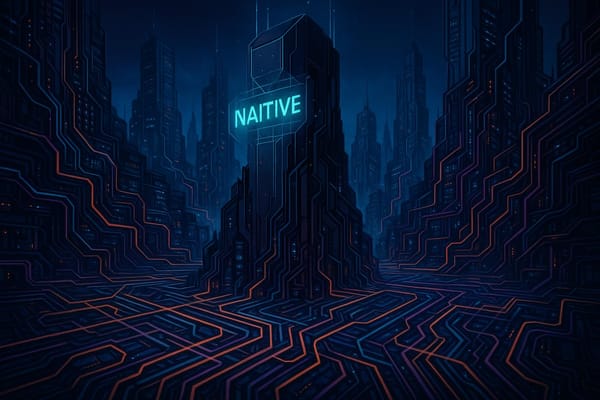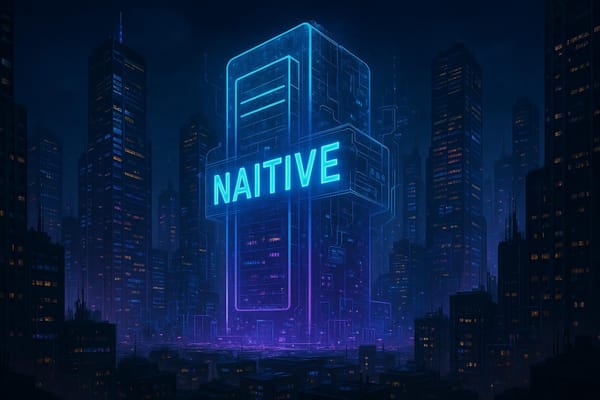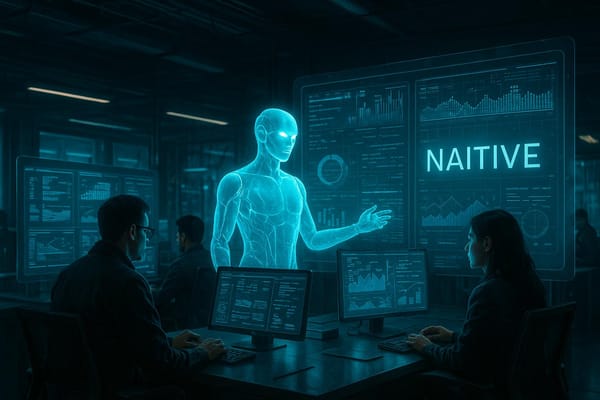Scaling Multi-Agent AI Systems for Interoperability
Explore how scaling multi-agent AI systems enhances interoperability, boosts efficiency, and addresses challenges in complex environments.

Scaling multi-agent AI systems is about enabling multiple autonomous agents to work together efficiently, particularly in complex business environments. These systems are transforming industries like logistics, healthcare, and defense by improving task accuracy, saving time, and reducing costs. However, achieving interoperability - where agents seamlessly communicate and collaborate - is critical for success.
Key Takeaways:
- Benefits: Multi-agent systems are 37.6% more accurate for specialized tasks and can save enterprises $1.94 million annually in labor costs.
- Interoperability: Standardized protocols like Agent-to-Agent (A2A) and Model Context Protocol (MCP) allow agents from different vendors to collaborate effectively.
- Core Components: Scalable systems rely on robust communication protocols, efficient coordination mechanisms, and shared knowledge bases.
- Challenges: Scaling introduces issues like communication bottlenecks, data synchronization problems, and resource management complexities.
- Best Practices: Real-time monitoring, feedback loops, and standardization are essential for ensuring smooth operations and reducing integration hurdles.
The future of multi-agent AI systems lies in decentralized autonomy, deeper integration with business processes, and improved explainability. With the market expected to grow exponentially, businesses must invest in scalable, interoperable frameworks to stay competitive.
The Future of AI: Building Multi-Agent Systems
Key Components for Scalable Multi-Agent AI Interoperability
Creating scalable multi-agent AI systems hinges on three core elements that enable smooth communication and coordination among agents. These components are essential for ensuring agents work together effectively while maintaining high performance, even as systems grow in complexity.
Agent Communication Protocols
Standardized communication protocols are critical for enabling diverse AI agents to interact seamlessly. Three protocols are shaping the landscape of agent communication:
- Model Context Protocol (MCP): Acts as a universal adapter, connecting agents to external tools, APIs, and data sources. This ensures agents can ground their responses in real-time context.
- Agent-to-Agent Protocol (A2A): Provides a structured framework for direct communication between agents, supporting discovery, messaging, and capability negotiation.
- Agent Communication Protocol (ACP): Focuses on orchestrating workflows, delegating tasks, and maintaining state across multiple agents.
As Kathy Pham, VP of Artificial Intelligence at Workday, highlights:
"Those who know how to use those protocols will build solutions well beyond what we each can do alone."
Layering these protocols enhances system resilience. For instance, in smart home energy management, MCP connects agents to weather APIs and device controls, A2A enables coordination between HVAC and solar management, and ACP oversees the entire optimization workflow. Similarly, enterprise document processing benefits from this layered approach, with MCP facilitating tool access, A2A enabling agent collaboration, and ACP managing the workflow.
Coordination and Management Systems
Once robust communication protocols are in place, effective coordination systems ensure smooth decision-making and task distribution. These systems tackle challenges like resource contention, redundancy, deadlocks, and conflicting objectives in complex environments.
- Centralized Coordination: Relies on a single agent or control system to manage a global state and make decisions. This approach offers predictable behavior and global optimization but can become a single point of failure and face computational bottlenecks as the number of agents increases.
- Distributed Coordination: Spreads decision-making across multiple agents, improving scalability and fault tolerance. However, this method requires more sophisticated mechanisms to manage coordination.
- Hybrid Models: Combine centralized and distributed approaches, using centralization for critical decisions while delegating routine tasks to distributed agents.
The benefits of well-designed coordination systems are evident. Companies using AI-driven coordination report 30% faster skill acquisition and a 50% increase in training engagement. In financial markets, hedge funds leveraging AI-powered intelligence achieve prediction accuracies of up to 80%, showcasing the value of advanced coordination.
Shared Knowledge Bases
Centralized knowledge repositories play a key role in enabling agents to access consistent data, ensuring coordinated decision-making and eliminating information silos. By sharing context - such as process states, historical decisions, and ongoing activities - agents maintain continuity during transitions and handoffs.
Real-time data synchronization is especially important in dynamic settings. For example, in supply chain automation, agents managing procurement, logistics, and inventory adapt to real-time changes to ensure timely deliveries and cost efficiency. Similarly, in customer support automation, agents across CRM, ticketing, and communication platforms collaborate using shared knowledge bases, enabling consistent application of company policies and seamless access to historical interactions.
Together, these three components - communication protocols, coordination systems, and shared knowledge bases - form the backbone of scalable multi-agent AI systems. Their effective implementation is essential for overcoming the challenges of scaling and unlocking the full potential of multi-agent AI in enterprise environments.
Challenges in Scaling Multi-Agent Systems for Interoperability
Expanding multi-agent systems to operate at scale brings a host of challenges, particularly when it comes to maintaining interoperability. As these systems grow, technical hurdles can strain performance and reliability. Addressing these issues is vital for enterprises aiming to ensure smooth operations in large-scale deployments.
Communication Bottlenecks
Communication often becomes the Achilles' heel of scaling multi-agent systems. When agents exchange large volumes of data, network resources can become overwhelmed, leading to slowdowns across the system. Bandwidth limitations are a key factor, but the complexity doesn’t stop there.
Deciding what data to share, when to share it, and how to share it is a balancing act. Poor decisions can drag down system performance, especially as networks expand. On top of that, agents need to juggle their individual tasks while staying aligned with the broader system goals. Add varying data formats and protocols into the mix, and you’ve got a recipe for synchronization headaches.
Security concerns further complicate communication. Protecting data through encryption and authentication is essential, but these measures add computational overhead, which can worsen bottlenecks. As Dr. Christopher Amato from Northeastern University puts it:
"The key to success in multi-agent systems isn't just about choosing between centralized or decentralized communication - it's about understanding how each approach shapes the fundamental tradeoffs between coordination, scalability, and robustness."
Centralized communication can create choke points, while decentralized methods spread the load but require more sophisticated coordination. Strategies like selective communication - where agents only share information that directly supports system goals - can help. Adaptive AI techniques and attentional communication models are also showing promise in tackling these challenges.
Data Consistency and Synchronization
Ensuring consistent data across a distributed network of agents becomes significantly harder as systems grow. The main issue lies in state consistency - making sure all agents operate with accurate, synchronized information despite asynchronous updates and partial data access.
Conflicting information among agents can lead to contradictory decisions. For instance, simultaneous updates require robust coordination to establish which state is authoritative, especially when network delays create timing uncertainties. Distributed consensus algorithms like Paxos and Raft can help maintain consistency, but they come with trade-offs, often slowing down system responsiveness.
To address these challenges, teams can implement tools like versioned state tracking and conflict detection systems. Techniques such as vector clocks or logical timestamps can help manage the order of events in distributed environments. Regular snapshots of the system’s state, combined with rollback capabilities, allow agents to revert to a stable state when synchronization issues arise.
Load Balancing and Resource Management
As multi-agent systems scale, efficiently managing resources becomes a critical challenge. The global multi-agent systems market reflects this growing need, with projections showing growth from $2.2 billion in 2023 to $5.9 billion by 2028.
Dynamic resource allocation is particularly tricky due to incomplete information and fluctuating demands. Techniques like auction-based mechanisms, market-inspired bidding, and decentralized optimization can help distribute resources effectively. Multi-agent reinforcement learning (MARL) also offers a way forward, enabling agents to adapt and learn continuously while supporting decentralized decision-making.
In cloud computing, for example, agents representing virtual machines can bid for CPU or memory resources in simulated markets, ensuring resources go to those that need them most. Real-time monitoring is crucial for maintaining stability, with anomaly detection focusing on interaction patterns rather than isolated metrics. Adaptive arbitration can then adjust how conflicts are resolved based on their severity.
Effective strategies include centralized management tools for better visibility, AI-driven analytics to optimize workloads, and cloud infrastructure to scale resources as needed. Circuit breaker patterns can also prevent cascading failures when conflicts can’t be resolved quickly.
The choice between centralized and distributed resource allocation comes with its own trade-offs. Centralized systems reduce communication overhead but may struggle with scalability, while distributed systems offer better scalability and fault tolerance at the cost of added complexity. Success ultimately depends on adaptive management approaches that evolve alongside system demands.
Best Practices for Scalable Interoperability
Scaling multi-agent AI systems while maintaining smooth interoperability demands a well-thought-out approach. Companies adopting these systems have reported cutting costs by up to 30% and boosting productivity by around 35%. The secret lies in building practices that grow alongside your system.
Real-Time Monitoring and Analytics
Shifting from reactive problem-solving to proactive system management starts with effective monitoring. Real-time analytics allow you to detect potential issues before they escalate into larger problems.
Dynamic benchmarking is key here - it involves setting performance baselines for various operational scenarios and tracking metrics to identify performance dips. Your monitoring tools should evaluate both how individual agents perform and how well they interact with each other, using automated tracking.
Visual dashboards can simplify this process. These dashboards should display stability metrics clearly and include alerts for different levels of severity. Regular stability tests during deployment and maintaining a history of performance data can help identify long-term trends.
Amazon Robotics provides a real-world example. In their fulfillment centers, thousands of robots work seamlessly together to handle inventory, move products, and prepare orders for shipping. Each robot acts independently yet communicates with others to avoid collisions and optimize routes, ensuring smooth operations even during peak demand.
These insights from real-time monitoring lay the groundwork for continuous improvement.
Feedback Loops and Continuous Improvement
Feedback loops are essential for addressing synchronization challenges and enabling systems to adapt over time. By incorporating robust feedback mechanisms, multi-agent systems can refine their behavior and improve overall performance through ongoing evaluation.
The healthcare industry offers an illustrative example. In 2025, Productive Edge implemented an AI-driven hospital discharge management system. This system used multiple agents: a Discharge Agent that analyzed patient data, a Coordination Agent that updated care teams in real time, and an Engagement Agent that provided personalized instructions to patients. The results were striking - hospital readmissions dropped by 30%, the average length of stay decreased by 11%, and bed turnover improved by 17%.
To implement feedback systems effectively, set clear performance metrics and establish channels for user evaluations. Analyze agent interactions regularly to catch anomalies early and adjust protocols as needed. Simulation testing is another valuable tool, allowing you to assess coordination, emergent behaviors, and safety measures at scale before deployment.
Standardization and Protocol Alignment
Standardized protocols are the backbone of seamless multi-agent communication. Without them, agents may struggle to interact effectively, leading to inefficiencies and integration hurdles.
The industry is making strides toward standardization through initiatives like AGNTCY, a collaboration between Cisco, LangChain, LlamaIndex, Galileo, and Glean. This open-source effort aims to create a universal language for AI agent communication. LangChain, a key contributor, has developed the Agent Protocol, enabling interoperability with frameworks like AutoGen and CrewAI.
Another approach is Agent-to-Agent (A2A) protocols, which use widely understood standards to simplify adoption. The Model Context Protocol (MCP) complements A2A by enabling AI assistants to work seamlessly across different systems. Companies like Replit, Codeium, and Sourcegraph have integrated MCP, allowing agents to retrieve data and generate more precise outputs. AI-powered IDEs such as Cursor, Windsurf, and Zed also use MCP to interact with tools like version control and file systems.
Adoption is growing fast - over 1,000 MCP servers are already in operation. This ecosystem highlights how standardization can streamline development and ease integration challenges.
For enterprise applications, consider implementing:
- Custom multi-factor authentication with dynamic token generation and regular credential updates.
- Decentralized routing algorithms optimized through machine learning.
- Quantum-resistant encryption with ephemeral key exchange mechanisms.
Trust and reputation systems are equally important. Develop scoring systems for agents, real-time trust evaluation algorithms, and adaptive access control frameworks. Logging all agent communications using blockchain-like methods ensures traceability and security.
The market potential is immense. While only 10% of businesses currently use AI agents, 82% plan to adopt them within the next 1–3 years. By 2030, the market for AI agents is expected to hit $47.1 billion. This growth makes standardization a necessity for maintaining interoperability at scale.
When addressing integration challenges, you’ll need to choose the right coordination mechanism for your system. Here's a breakdown:
| Coordination Mechanism | Description |
|---|---|
| Emergent | Agents act independently, creating coordination-like behavior through environmental interaction. |
| Intentional | Agents communicate directly to avoid conflicts and coordinate tasks. |
| Market-Based | Tasks are coordinated through auction-based algorithms and pricing mechanisms. |
| Hierarchical | A centralized structure defines roles and tasks for agents. |
| Social Networks | Agents rely on trust and relationships to coordinate tasks. |
Each mechanism has its strengths. Market-based methods are ideal for resource allocation, hierarchical systems work well for complex governance, and social network approaches thrive in trust-based environments. Selecting the right one is critical to achieving effective standardization.
Future Directions in Multi-Agent AI System Scalability
The world of multi-agent AI systems is advancing at an extraordinary pace, with new technologies redefining how these systems scale and work together. Projections suggest the global AI agent market will skyrocket from $5.29 billion in 2024 to $216.8 billion by 2035, growing annually at an impressive 40.15%. This surge reflects a shift in how AI systems operate and collaborate, paving the way for transformative possibilities.
Advances in Agent Autonomy and Self-Organization
A major leap forward for scalable multi-agent systems is the move away from centralized control toward greater autonomy and self-organization. Instead of relying on a central authority, these systems are evolving to let agents self-adapt and coordinate independently. This decentralized approach is already yielding results, with multi-agent systems outperforming single-agent models by as much as 90% in certain scenarios.
What makes these systems stand out is their flexibility. They can adjust to dynamic environments by adding, removing, or modifying agents as needed, making them ideal for tackling complex challenges. Decentralized control mechanisms allow agents to act autonomously while still aligning with overarching system goals.
Practical applications are already reshaping industries. For example, in software development, specialized sub-models handle repetitive tasks like user authentication, streamlining processes into automated workflows. This has led to a 30% reduction in total development hours. As these systems grow more intricate, defining clear roles and responsibilities for agents will become increasingly important.
Integration with Business Process Automation
Multi-agent systems are set to transform enterprise operations by embedding themselves deeper into business process automation. With the rise of cloud computing, machine learning, and adaptive automation, agents are becoming central to modern workflows. A prime example is Microsoft's Azure AI Foundry Agent Service, launched in May 2025. This platform enables developers to create and manage specialized AI agents that function within long-running, reliable workflows. Its architecture ensures system stability by handling delays or errors with retries and fallback mechanisms.
By 2028, experts predict that 15% of daily business decisions will be made autonomously. This shift promises to turn reactive processes into proactive, streamlined operations. Future advancements will also see multi-agent systems incorporating natural language processing and emotion recognition, creating personalized user experiences tailored to individual needs.
Key technologies driving this evolution include Message-Oriented Middleware, WebRTC, RESTful APIs, gRPC, and Event-Driven Architectures. Organizations looking to stay ahead should focus on mastering agent design patterns, exploring agent-oriented architectures like agent meshes, and experimenting with autonomous agents capable of learning, adapting, and collaborating. These advancements will also enhance transparency and accountability in increasingly complex systems.
The Role of Explainability and Observability
As multi-agent systems grow more autonomous and intricate, the need for transparency and accountability becomes paramount. Explainable AI (XAI) is emerging as a crucial component in the development of these systems. Unlike single-agent models, where decision-making is relatively straightforward, multi-agent environments involve complex interactions that require clear explanations to understand how outcomes are achieved.
Future frameworks will focus on monitoring both individual agent performance and the collective intelligence of agent networks. This includes analyzing behavior, interaction patterns, and decision-making processes. Federated learning approaches will also play a key role, allowing agents to learn from distributed data while safeguarding privacy.
Human-agent collaboration is evolving as well, with systems designed to provide clear insights into their reasoning processes. This transparency builds trust and ensures alignment with organizational objectives. Semantic interoperability frameworks will further improve explainability by establishing shared vocabularies and ontologies, making agent communication more transparent and easier to understand.
Balancing autonomy with transparency will be critical as these technologies mature. Organizations must ensure that while agents operate independently, they remain fully accountable for their actions. For businesses aiming to adopt and integrate these advancements, expert guidance is essential. NAITIVE AI Consulting Agency offers tailored solutions to help organizations navigate this new era of scalable multi-agent systems and drive meaningful transformation.
Conclusion: Achieving Scalable Interoperability in Multi-Agent AI Systems
Creating scalable interoperability in multi-agent AI systems requires a thoughtful mix of technical precision and business-driven strategies. With the global AI market expected to hit $190 billion by 2025 and 70% of companies already integrating AI into their operations, the pressure to get this right is immense. This combination of technical and business priorities lays the groundwork for systems designed to perform and deliver results.
Laying the Groundwork begins with establishing strong communication protocols and modular system architectures. These foundational choices can deliver big payoffs. For example, companies using domain-specific agents report 37.6% higher precision compared to generalist AI agents, while also slashing validation times by 61.2%. These figures highlight the tangible benefits of making smart architectural decisions.
Operational Efficiency is achieved through real-time monitoring, standardized processes, and consistent feedback mechanisms. Take JPMorgan's COIN system, which replaced 360,000 hours of annual legal document review with automated analysis completed in seconds. Similarly, Microsoft's Azure AI Foundry Agent Service showcases how specialized agents ensure system reliability with intelligent retry and fallback strategies. These examples emphasize how operational excellence underpins scalable interoperability.
The value of standardized interoperability is widely acknowledged by industry leaders. Brendan Haire from Atlassian captures this sentiment perfectly:
"With Atlassian's investment in Rovo agents, the development of a standardized protocol like A2A will help agents successfully discover, coordinate, and reason with one another to enable richer forms of delegation and collaboration at scale."
Aligning technical standards with business goals solidifies scalable interoperability as a key driver of enterprise transformation.
Achieving success in this area requires both technical breakthroughs and strategic planning. From defining clear agent roles to implementing strong communication frameworks, the challenges of building scalable multi-agent systems are complex. For organizations serious about this transformation, professional guidance is essential.
NAITIVE AI Consulting Agency specializes in autonomous AI agents and business process automation, offering the expertise businesses need to overcome these challenges. Their commitment to developing advanced AI agents ensures companies can fully realize the potential of multi-agent systems.
FAQs
How do protocols like Agent-to-Agent (A2A) and Model Context Protocol (MCP) improve interoperability in multi-agent AI systems?
Standardized protocols like Agent-to-Agent (A2A) and Model Context Protocol (MCP) are key to improving how multi-agent AI systems work together.
A2A facilitates smooth communication between autonomous agents, allowing them to share data securely and coordinate tasks across various platforms. This eliminates the need to rely heavily on specific vendors and opens up more flexibility for system design.
On the other hand, MCP serves as a bridge for large language models to connect with external tools. It ensures that data moves securely and efficiently between different AI components. When combined, these protocols help create AI systems that are scalable, modular, and collaborative - perfect for handling the demands of complex enterprise operations.
What challenges do businesses face when scaling multi-agent AI systems, and how can they overcome them?
Scaling multi-agent AI systems comes with its fair share of hurdles. Common issues include communication bottlenecks, resource conflicts, and unpredictable behaviors that arise as agents interact in more intricate and interconnected ways. These challenges can negatively affect performance, hinder coordination, and compromise the system's reliability.
To tackle these obstacles, companies can implement scalable design patterns that streamline system growth. Enhancing communication protocols between agents is another critical step, as it ensures clearer and faster data exchange. Using orchestration frameworks can also help by efficiently managing how agents interact and collaborate. On top of that, deploying robust monitoring tools is essential. These tools can quickly identify and address unexpected behaviors, leading to smoother scaling and better integration across enterprise systems.
Why is explainability critical in multi-agent AI systems, and how does it support their integration into business operations?
The Importance of Explainability in Multi-Agent AI Systems
Explainability in multi-agent AI systems plays a key role in creating transparency and building trust. It gives businesses a clear understanding of how AI-driven decisions are made, which is essential for responsible use, maintaining accountability, and adhering to compliance standards. This clarity also ensures that human oversight remains a part of the process, helping to manage risks and support ethical AI practices.
When stakeholders trust these systems, it's much easier to integrate AI into critical business workflows and decision-making processes. As these systems become increasingly intricate, having a clear view of their operations not only boosts efficiency but also strengthens confidence in their results. This makes explainability a cornerstone for enterprises navigating the modern AI landscape.




